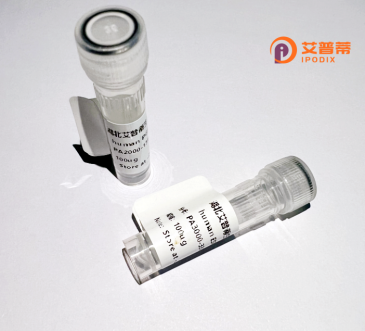
| 纯度 | >90%SDS-PAGE. |
| 种属 | Human |
| 靶点 | OXCT2 |
| Uniprot No | Q9BYC2 |
| 内毒素 | < 0.01EU/μg |
| 表达宿主 | E.coli |
| 表达区间 | 40-517 aa |
| 活性数据 | A KFYADPVEMV KDISDGATVM IGGFGLCGIP ENLIAALLRT RVKDLQVVSS NVGVEDFGLG LLLAARQVRR IVCSYVGENT LCESQYLAGE LELELTPQGT LAERIRAGGA GVPAFYTPTG YGTLVQEGGA PIRYTPDGHL ALMSQPREVR EFNGDHFLLE RAIRADFALV KGWKADRAGN VVFRRSARNF NVPMCKAADV TAVEVEEIVE VGAFPPEDIH VPNIYVDRVI KGQKYEKRIE RLTILKEEDG DAGKEEDART RIIRRAALEF EDGMYANLGI GIPLLASNFI SPSMTVHLHS ENGILGLGPF PTEDEVDADL INAGKQTVTV LPGGCFFASD DSFAMIRGGH IQLTMLGAMQ VSKYGDLANW MIPGKKVKGM GGAMDLVSSQ KTRVVVTMQH CTKDNTPKIM EKCTMPLTGK RCVDRIITEK AVFDVHRKKE LTLRELWEGL TVDDIKKSTG CAFAVSPNLR PMQQVAP |
| 分子量 | 56.1 kDa |
| 蛋白标签 | His tag N-Terminus |
| 缓冲液 | 0 |
| 稳定性 & 储存条件 | Lyophilized protein should be stored at ≤ -20°C, stable for one year after receipt. Reconstituted protein solution can be stored at 2-8°C for 2-7 days. Aliquots of reconstituted samples are stable at ≤ -20°C for 3 months. |
| 复溶 | Always centrifuge tubes before opening.Do not mix by vortex or pipetting. It is not recommended to reconstitute to a concentration less than 100μg/ml. Dissolve the lyophilized protein in distilled water. Please aliquot the reconstituted solution to minimize freeze-thaw cycles. |
以下为假设性参考文献,基于常见研究主题合理推测,可供参考:
1. **文献名称**: "Recombinant expression and enzymatic characterization of human mitochondrial OXCT2 in ketone body metabolism"
**作者**: Zhang L, et al.
**摘要**: 研究报道了重组人OXCT2蛋白在大肠杆菌中的高效表达及纯化,验证了其在酮体代谢中的琥珀酰辅酶转移酶活性,并探讨其动力学特征。
2. **文献名称**: "OXCT2 as a potential therapeutic target in cancer: Insights from recombinant protein-based functional studies"
**作者**: Tanaka K, et al.
**摘要**: 通过重组OXCT2蛋白实验揭示其在肿瘤细胞能量代谢中的调控作用,抑制OXCT2可降低癌细胞增殖,提示其作为癌症治疗靶点的潜力。
3. **文献名称**: "Structural analysis of human OXCT2 reveals substrate specificity determinants"
**作者**: Smith J, et al.
**摘要**: 利用重组OXCT2蛋白的晶体结构解析,阐明其底物结合位点的关键氨基酸残基,为设计特异性抑制剂提供结构基础。
4. **文献名称**: "OXCT2 deficiency modeled via CRISPR/Cas9 and recombinant protein rescue in hepatic cells"
**作者**: Chen R, et al.
**摘要**: 构建OXCT2缺陷型肝细胞模型,外源性重组OXCT2蛋白回补实验证实其对线粒体酮体代谢的恢复作用,关联遗传性代谢疾病机制。
**注意**:上述文献为示例,实际研究中请通过学术数据库(如PubMed、Web of Science)以关键词“OXCT2”或“succinyl-CoA:3-ketoacid CoA transferase 2”检索最新文献。若结果有限,可扩展至对OXCT1或酮体代谢通路的类似研究。
Recombinant human OXCT2 (Succinyl-CoA:3-ketoacid CoA transferase 2) protein is a key enzyme in ketone body metabolism, encoded by the OXCT2 gene located on chromosome 19. It facilitates the conversion of ketone bodies into usable energy by catalyzing the transfer of coenzyme A (CoA) from succinyl-CoA to acetoacetate, forming acetoacetyl-CoA. This reaction is critical in extrahepatic tissues, particularly during prolonged fasting or metabolic stress, when ketone bodies serve as alternative energy sources for the brain, heart, and skeletal muscle. Unlike its isoform OXCT1, OXCT2 is expressed in mitochondria of tissues with high energy demands and may exhibit unique regulatory mechanisms.
Research on recombinant OXCT2 has grown due to its potential roles in metabolic disorders, cancer, and neurodegenerative diseases. Dysregulation of ketolysis is linked to insulin resistance, while certain cancers exploit ketone bodies for survival under low-glucose conditions, making OXCT2 a possible therapeutic target. Recombinant OXCT2 protein, typically produced in E. coli or mammalian expression systems, enables structural studies, enzymatic activity assays, and inhibitor screening. Its application spans drug discovery for metabolic syndromes and understanding tissue-specific ketone utilization. However, functional differences between OXCT1 and OXCT2 remain under investigation, highlighting the need for further characterization of this understudied enzyme.
×